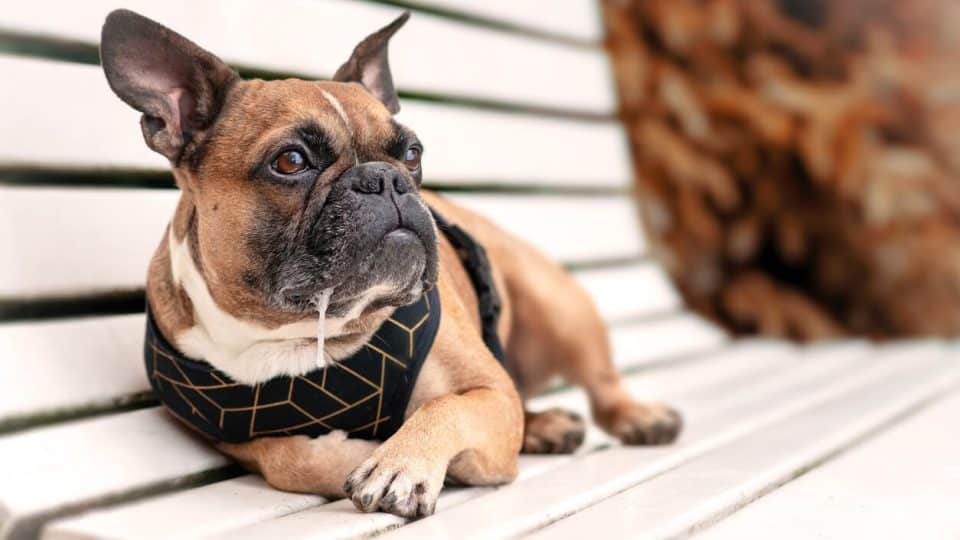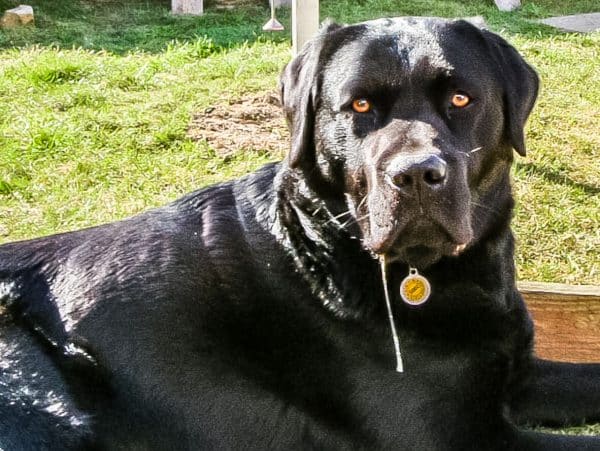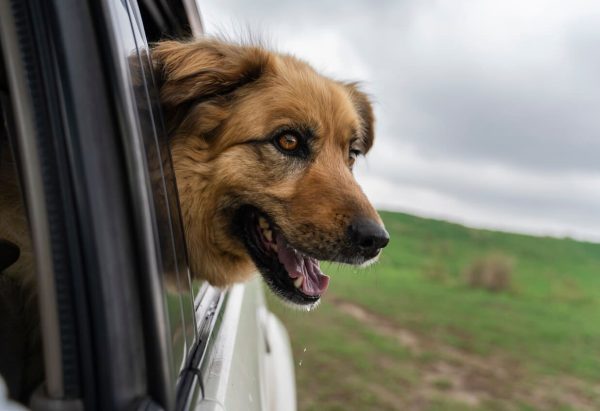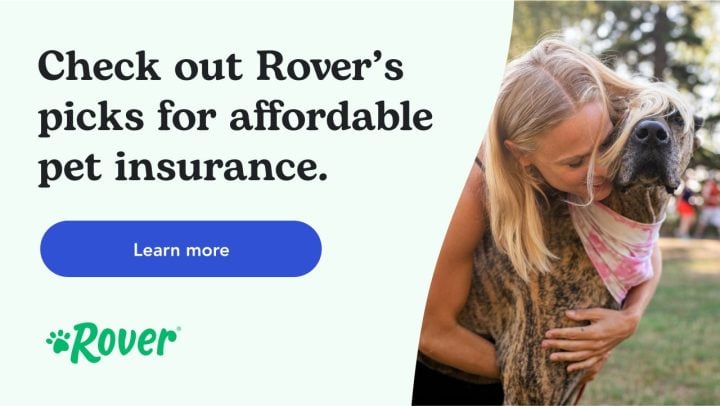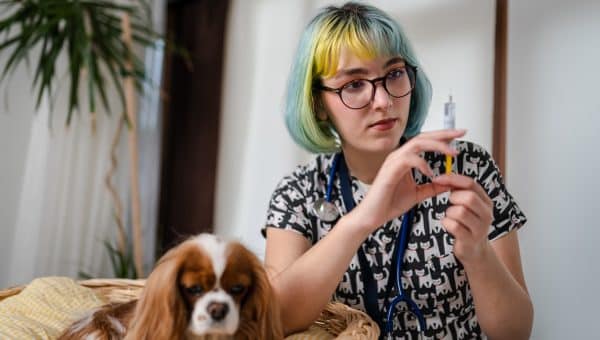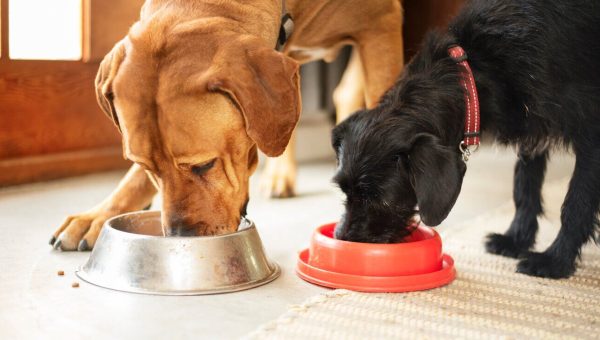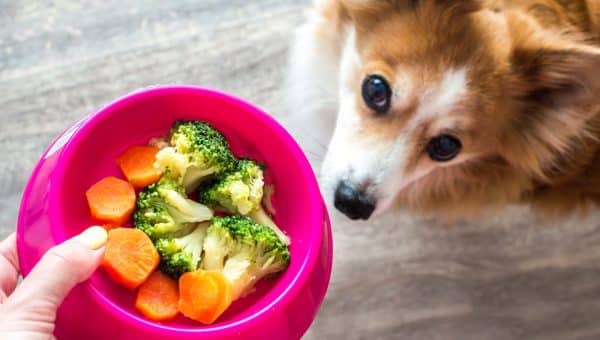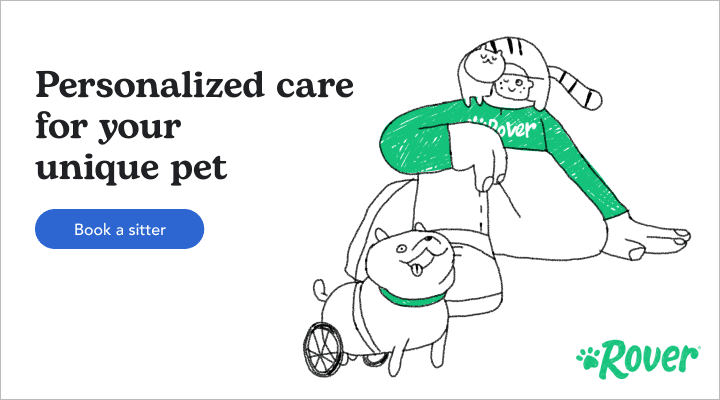- Not a substitute for professional veterinary help.
Your dog might drool for many reasons, including stress, illness, environmental triggers like food or a car ride, or the shape of their mouth. In short, dog slobber is a pretty common occurrence.
If your dog has suddenly started drooling much more than usual, however, you may want to check in with your vet—this could point to an underlying health concern, says Danny Sack, DVM, a veterinary surgery resident at MedVet Columbus and Big Barker Veterinarian Expert.
Below, find eight reasons why dogs drool, plus symptoms to pay attention to and signs it’s time to contact your vet. We’ll also share helpful ways to manage excessive drooling.
Anxiety Or Stress
“Lip licking is a behavior dogs use to signal to other dogs and people that they’re uncomfortable or unsure about the current situation,” Dr. Sack says.
When your dog licks their lips while drooling, they may be feeling stressed or anxious due to any of these situations:
- Loud sounds, like storms, fireworks, vacuum cleaners, and vehicles
- Travel
- Separation
- The presence of an unknown person
According to Dr. Sack, lip licking and drooling don’t always mean your dog has anxiety. If they do, you may also notice:
Age
“While age itself doesn’t increase drooling, pathologies in the mouth are more common in older dogs,” says Dr. Jennifer Sperry, BSc, DVM. These oral health conditions may include periodontal disease, oral ulcers, and oral masses.
According to Dr. Sperry, these issues can increase saliva production or disrupt the seal around the oral cavity. As a result, you may notice more saliva than usual escaping from their mouth.
Oral Health
Oral and dental disorders can affect dogs of any age. Conditions that may cause your dog to drool more include:
- Gum disease: This is the most common oral concern for small dogs.
- Fungal stomatitis: This uncommon condition results from an overgrowth of the fungus Candida albicans.
- Trenchmouth: This rare disease may be caused by normal mouth bacteria and other microorganisms.
- Glossitis: This inflammation of the tongue can have different causes, such as infection, irritation, wounds, or contact with chemicals.
- Mouth burns: These mouth injuries may result from heat, chemical, or electrical burns.
- Malignant tumors: These cancerous tumors could be melanoma, squamous cell carcinoma, or fibrosarcoma.
- Ptyalism: This type of drooling happens when a dog produces too much saliva or has trouble swallowing saliva.
- Sialadenosis: This condition involves swelling of the salivary glands behind a dog’s jaw.
- Necrotizing sialometaplasia: This condition most commonly affects small breeds between the ages of 3 and 8 years.
Many oral disorders are treatable, and regular oral exams can help prevent or diagnose mouth-related concerns.
It’s also important to brush your dog’s teeth to prevent plaque and tartar formation.
According to Dr. Joanna Woodnutt, BVM, BVS, MRCVS, with The Veterinary Content Company, you should brush your dog’s teeth daily or every other day. Your dog may also need a professional tooth cleaning under sedation. Your vet can make recommendations about how often to have this done.
Breed
Specific dog breeds don’t automatically produce more saliva, but some mouth shapes can make it easier for saliva to spill out the oral cavity, Dr. Sperry says.
Wild canids, like wolves, coyotes, and mongrel dogs, have smooth, flat lips that form a seal against each other and their teeth. “When we selectively bred dogs, we changed the shape of their jaws and lips and added facial folds that allow saliva to escape,” Dr. Sperry explains.
Dog breeds with large, hanging lips, short noses, or facial folds are more prone to drooling than others. Hanging jowls, prominent upper lips, short noses, facial folds, and dental malocclusions (over- or underbites) can all contribute to drooling.
Breeds known to drool more than others include:
Digestive Issues And Nausea
Dr. Aziza Glass, DVM, CVA, with CAWLM, says the following digestive issues can cause nausea and result in drooling:
- A foreign body or non-food item that obstructs the digestive system
- Gastroenteritis, which is an inflammation of the stomach and intestinal tract due to diet, stress, or a health concern
- Stomach ulcers, which are lesions on the stomach lining
- Infections like Parvovirus
- Abdominal pain or inflammation caused by food that’s gone bad or isn’t dog-friendly
- Exposure to toxic substances
- Carsickness
- Vestibular diseases like vertigo
Kidney Or Liver Disease
Excessive drooling could point to an organ disease, such as kidney or liver disease, Dr. Glass says.
These diseases involve an increase in toxins circulating the blood from a decreased “filtering” function of the liver. Dogs may drool more in order to eliminate these toxins.
Other possible symptoms of an organ disease include:
- Upset stomach
- Uncoordinated movements
- Eating less than usual
- Drinking more water than usual
- Lethargy
Rabies
Although rabies is rare for pets and more common in wildlife animals, it can cause excessive drooling.
Other signs of rabies include:
- Lethargy
- Fever
- Vomiting
- Lack of appetite
- Weakness
- Seizures
- Difficulty breathing and/or swallowing
- Aggression
Rabies is a fatal virus that can be transmitted to humans and other pets. You can prevent rabies by keeping your dog up-to-date on their rabies vaccine. It’s also important to supervise your dog outdoors so you can make sure they don’t come into contact with unknown animals—and that you can get them treatment right away if they do.
If your dog has signs of rabies, call your vet immediately. Avoid going near your dog until you have more guidance from your vet.
Heat Stroke
Dogs experiencing heat stroke may drool to help cool themselves down. Along with excessive drooling and panting, other signs of heat stroke include vomiting and loss of coordination.
If you believe your dog may be experiencing heat stroke, call your vet right away. They’ll want to check your dog out as soon as possible. In the meantime, you can use cool water, ice packs, or wet towels to cool down their head and body, especially their belly. Eventually, you can offer a small amount of water.
Just check with your vet first and follow any directions they give you.
Environment
The body makes saliva in response to various stimuli in the environment, so your dog can’t control the amount of slobber they produce, Dr. Woodnutt explains.
For instance, one very common trigger for saliva production and drooling is the sight or smell of food. Saliva production actually has benefit here, since the enzymes in saliva help with digestion.
Being in a car can also cause dogs to drool, possibly because they feel nervous or carsick, according to Dr. Woodnutt.
Some dogs also drool more around other dogs. This could be a hormonal response if your dog isn’t neutered, but it often happens due to anxiety, Dr. Woodnutt explains.
Dogs also produce more saliva when they smell something that interests them—like another dog!
What To Do If Your Dog Drools Constantly
“While drooling is a normal behavior for dogs, excessive drooling can indicate an underlying issue,” according to
Has your dog suddenly started drooling a lot? Dr. Sara Ochoa, DVM, a veterinarian with Animal Hospital, recommends these steps:
- Assess the situation: Start by observing your dog’s behavior and environment to help you figure out if you should take action. For instance, could they swallowed something toxic or a large object? Are they in an unfamiliar situation, or around a new pet or person that might cause stress?
- Check for mouth injuries or foreign objects: Carefully examine your dog’s mouth for any signs of injury, such as bleeding, cuts, or sores. Additionally, check for foreign objects stuck in their mouth, like bones or toys. If you see anything lodged inside, don’t attempt to remove it yourself. You may unintentionally cause more damage. Instead, contact your vet for guidance.
- Check for signs of distress: If you notice symptoms like difficulty breathing, vomiting, diarrhea, pale gums, or collapse, seek emergency veterinary care immediately.
- Keep calm and comfort your dog: Dogs can sense your mood and emotions, so staying calm can help you avoid adding to their distress. Comforting them with gentle words and soothing gestures can help ease any stress they’re experiencing.
- Contact your veterinarian: If your dog’s excessive drooling persists or you can’t figure out any possible causes, a good next step involves contacting a vet. They can help find the cause of the drooling and recommend next steps.
